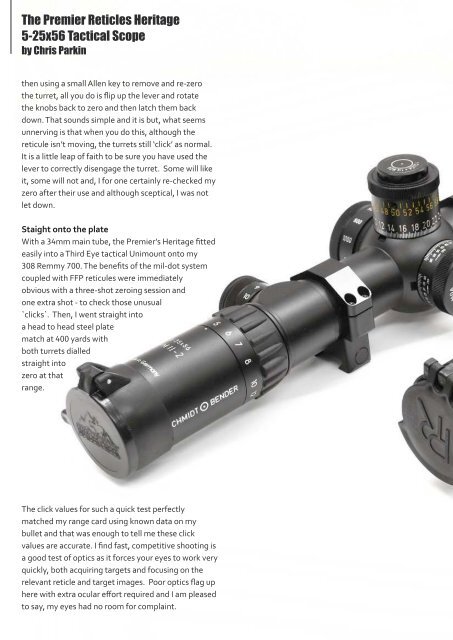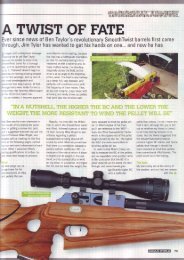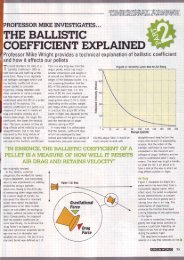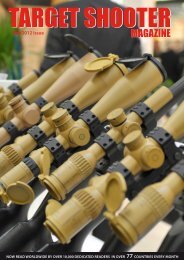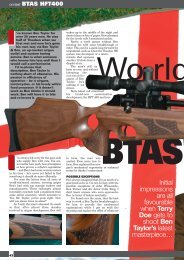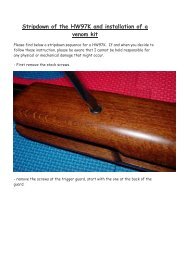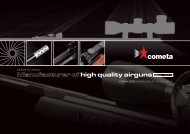February 2012 Issue - Target Shooter Magazine
February 2012 Issue - Target Shooter Magazine
February 2012 Issue - Target Shooter Magazine
Create successful ePaper yourself
Turn your PDF publications into a flip-book with our unique Google optimized e-Paper software.
The Premier Reticles Heritage<br />
5-25x56 Tactical Scope<br />
by Chris Parkin<br />
The Premier Reticles Heritage<br />
5-25x56 Tactical Scope<br />
by Chris Parkin<br />
then using a small Allen key to remove and re-zero<br />
the turret, all you do is flip up the lever and rotate<br />
the knobs back to zero and then latch them back<br />
down. That sounds simple and it is but, what seems<br />
unnerving is that when you do this, although the<br />
reticule isn’t moving, the turrets still ‘click’ as normal.<br />
It is a little leap of faith to be sure you have used the<br />
lever to correctly disengage the turret. Some will like<br />
it, some will not and, I for one certainly re-checked my<br />
zero after their use and although sceptical, I was not<br />
let down.<br />
Staight onto the plate<br />
With a 34mm main tube, the Premier’s Heritage fitted<br />
easily into a Third Eye tactical Unimount onto my<br />
308 Remmy 700. The benefits of the mil-dot system<br />
coupled with FFP reticules were immediately<br />
obvious with a three-shot zeroing session and<br />
one extra shot - to check those unusual<br />
`clicks`. Then, I went straight into<br />
a head to head steel plate<br />
match at 400 yards with<br />
both turrets dialled<br />
straight into<br />
zero at that<br />
range.<br />
The click values for such a quick test perfectly<br />
matched my range card using known data on my<br />
bullet and that was enough to tell me these click<br />
values are accurate. I find fast, competitive shooting is<br />
a good test of optics as it forces your eyes to work very<br />
quickly, both acquiring targets and focusing on the<br />
relevant reticle and target images. Poor optics flag up<br />
here with extra ocular effort required and I am pleased<br />
to say, my eyes had no room for complaint.<br />
Familiar looks...<br />
Familiar ethos...<br />
Familiar glass...<br />
Both the field of view and edge-to-edge clarity were<br />
exemplary. Although this competition was single<br />
aiming point territory, the 0.5 and 1 mil increments<br />
had worked in total harmony with the turrets to<br />
zero or aim off for wind, although below about 10x<br />
magnification, the reticule was getting very small and<br />
harder to gauge. Illumination covered the central tree<br />
but was generally only used on its highest setting as<br />
balanced against any quality of glass - there is no point<br />
seeing a reticle without an image to partner it.<br />
I tested the optics alongside a few other top-end<br />
scopes as light faded and I was very impressed with<br />
the extra field of view, clarity and brightness offered,<br />
no light conditions were encountered where any flare<br />
was a problem and colour rendition seemed honest.<br />
This is a very good scope and if you like first focal<br />
plane reticles, it certainly stands equal to competitors<br />
both optically and mechanically. There is more than a<br />
sniff of `German quality’ in the glass.<br />
10 11


